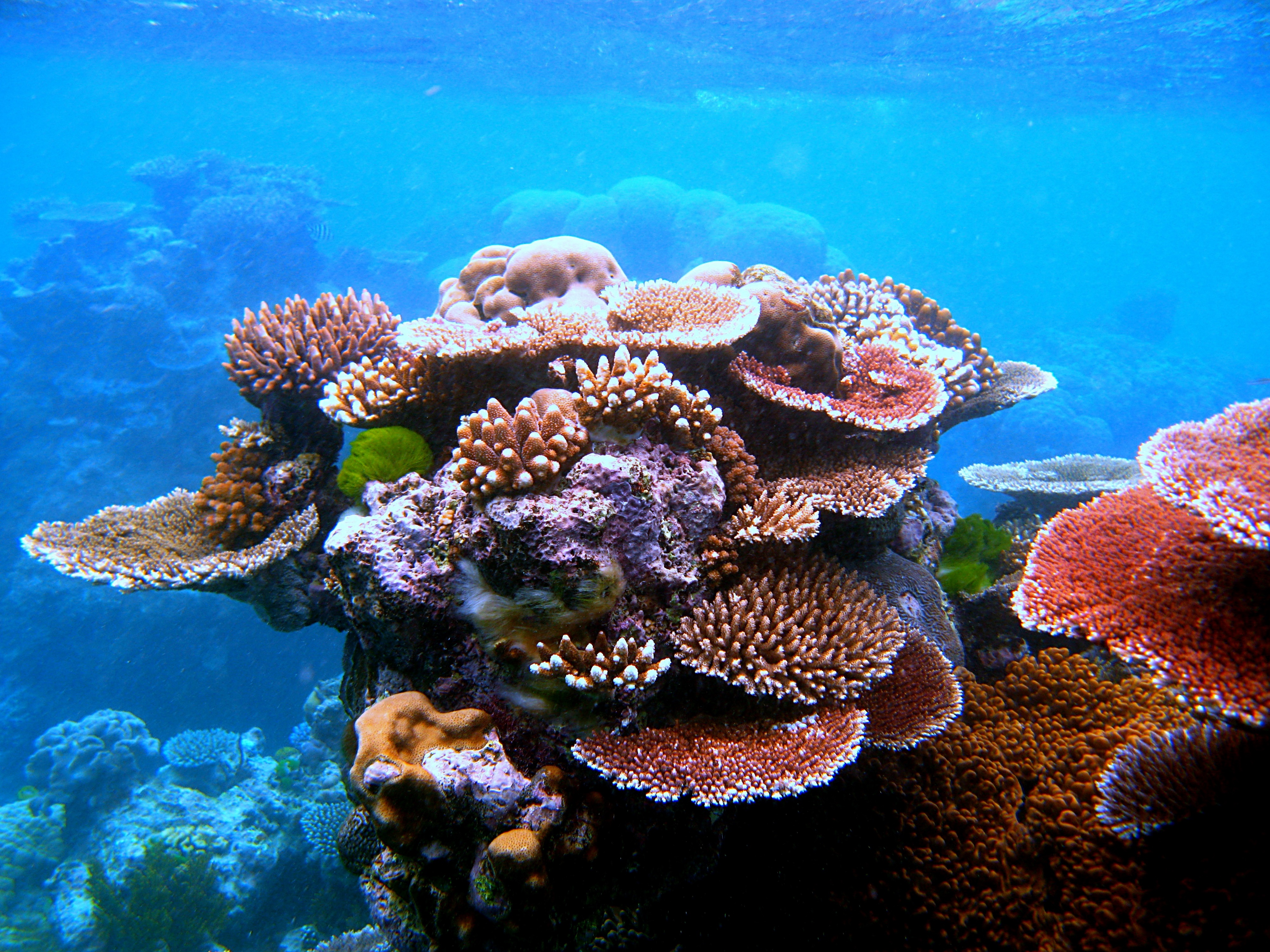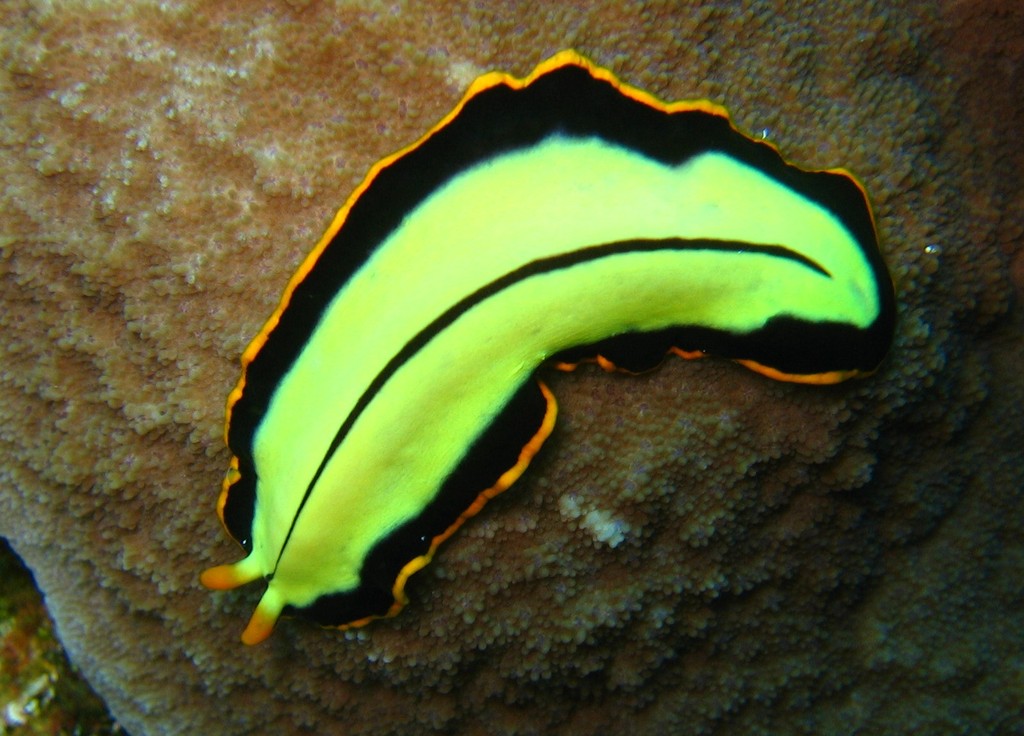|
Pseudoceros Scriptus
''Pseudoceros scriptus '' is a marine flatworm species that belongs to the Pseudocerotidae family. This species is commonly known as the script flatworm. Distribution Tropical Indo-Pacific, from the Archipelago of Maldives to Australia. Habitat External slope or top of coral reefs. Size Up to . Physical characteristics "External anatomy: Cream yellowish background fading to white towards the margin with irregular black maculae on either side of the median line and an orange marginal band. The ventral side is cream becoming darker towards the margin and a wide orange marginal band. The pseudotentacles are formed by simple folds of the anterior margin. Cerebral cluster with about 40 eyespots. Pharynx is formed by elaborated folds. Internal anatomy: The male system is formed by unbranched vas deferens, an oblong seminal vesicle, an oval prostatic vesicle, and a short cuticular stylet housed in a deep, folded, and voluminous antrum. The female antrum is shallow with a ... [...More Info...] [...Related Items...] OR: [Wikipedia] [Google] [Baidu] |
Polycladida
The Polycladida represents a highly diverse clade of free-living marine flatworms. They are known from the littoral to the sublittoral zone (extending to the deep hot vents), and many species are common from coral reefs. Only a few species are found in freshwater habitats. Description Polyclads range from to in length with a flattened, roughly oval, body shape and, in many cases, a pair of short tentacles on the head. They are distinguished from other related animals by the presence of a folded pharynx, an elongated intestine with numerous complex diverticula, and multiple ocelli. The etymology of the order name ''Polycladida'' corresponds to the two ancient Greek words (), meaning "numerous", and (), meaning "branch". It refers to the ramified shape of the intestine in these flatworms. Most polyclads hide away from direct light. However, some of the brightly colored species often are active during the day. With their flamboyant coloring they advertise their potential toxi ... [...More Info...] [...Related Items...] OR: [Wikipedia] [Google] [Baidu] |
Species
In biology, a species is the basic unit of Taxonomy (biology), classification and a taxonomic rank of an organism, as well as a unit of biodiversity. A species is often defined as the largest group of organisms in which any two individuals of the appropriate sexes or mating types can reproduction, produce Fertility, fertile offspring, typically by sexual reproduction. Other ways of defining species include their karyotype, DNA sequence, morphology (biology), morphology, behaviour or ecological niche. In addition, paleontologists use the concept of the chronospecies since fossil reproduction cannot be examined. The most recent rigorous estimate for the total number of species of eukaryotes is between 8 and 8.7 million. However, only about 14% of these had been described by 2011. All species (except viruses) are given a binomial nomenclature, two-part name, a "binomial". The first part of a binomial is the genus to which the species belongs. The second part is called the specifi ... [...More Info...] [...Related Items...] OR: [Wikipedia] [Google] [Baidu] |
Pseudocerotidae
Pseudocerotidae is a family of flatworm The flatworms, flat worms, Platyhelminthes, or platyhelminths (from the Greek πλατύ, ''platy'', meaning "flat" and ἕλμινς (root: ἑλμινθ-), ''helminth-'', meaning "worm") are a phylum of relatively simple bilaterian, unsegme ...s which includes the Bedford's flatworm. Pseudocerotidae are simple organisms categorized by their oval bodies and tentacles and bright colors. They use the cilia to glide along surfaces. Most commonly referred to as marine flatworms, closely related to the orders Macrostomorpha and Lecithoepitheliata. These organisms have very complex reproductive systems, no blood systems or organs for gas exchange, a simple brain and are hermaphroditic. Habitat Due to the anthropogenic transportation of non-native marine species, their species can be found all around the world in tropical and subtropical waters near coral reefs, shallow reefs, deep waters, water surfaces and in aquaculture areas. The mo ... [...More Info...] [...Related Items...] OR: [Wikipedia] [Google] [Baidu] |
Common Name
In biology, a common name of a taxon or organism (also known as a vernacular name, English name, colloquial name, country name, popular name, or farmer's name) is a name that is based on the normal language of everyday life; and is often contrasted with the scientific name for the same organism, which is Latinized. A common name is sometimes frequently used, but that is not always the case. In chemistry, IUPAC defines a common name as one that, although it unambiguously defines a chemical, does not follow the current systematic naming convention, such as acetone, systematically 2-propanone, while a vernacular name describes one used in a lab, trade or industry that does not unambiguously describe a single chemical, such as copper sulfate, which may refer to either copper(I) sulfate or copper(II) sulfate. Sometimes common names are created by authorities on one particular subject, in an attempt to make it possible for members of the general public (including such interested p ... [...More Info...] [...Related Items...] OR: [Wikipedia] [Google] [Baidu] |
Maldives
The Maldives, officially the Republic of Maldives,, ) and historically known as the Maldive Islands, is a country and archipelagic state in South Asia in the Indian Ocean. The Maldives is southwest of Sri Lanka and India, about from the Asian continent's mainland. The Maldives' chain of Atolls of the Maldives, 26 atolls stretches across the equator from Atolls of the Maldives#Ihavandhippolhu, Ihavandhippolhu Atoll in the north to Addu Atoll in the south. The Maldives is the smallest List of sovereign states and dependent territories in Asia, country in Asia. Including the sea, the territory spans roughly , and a land area of . The Maldives is one of the world's most geographically dispersed sovereign states, and the smallest Muslim world, Muslim-majority country by land area. With a population of 515,132 in the 2022 census, it is the 2nd List of Asian countries by population, least populous country in Asia and the List of countries and dependencies by area, ninth-smallest ... [...More Info...] [...Related Items...] OR: [Wikipedia] [Google] [Baidu] |
Australia
Australia, officially the Commonwealth of Australia, is a sovereign ''Sovereign'' is a title which can be applied to the highest leader in various categories. The word is borrowed from Old French , which is ultimately derived from the Latin , meaning 'above'. The roles of a sovereign vary from monarch, ruler or ... country comprising the mainland of the Australian continent, the island of Tasmania, and numerous smaller islands. With an area of , Australia is the largest country by area in Oceania and the world's sixth-largest country. Australia is the oldest, flattest, and driest inhabited continent, with the least fertile soils. It is a megadiverse country, and its size gives it a wide variety of landscapes and climates, with deserts in the centre, tropical Forests of Australia, rainforests in the north-east, and List of mountains in Australia, mountain ranges in the south-east. The ancestors of Aboriginal Australians began arriving from south east Asia approx ... [...More Info...] [...Related Items...] OR: [Wikipedia] [Google] [Baidu] |
Coral Reef
A coral reef is an underwater ecosystem characterized by reef-building corals. Reefs are formed of colonies of coral polyps held together by calcium carbonate. Most coral reefs are built from stony corals, whose polyps cluster in groups. Coral belongs to the class Anthozoa in the animal phylum Cnidaria, which includes sea anemones and jellyfish. Unlike sea anemones, corals secrete hard carbonate exoskeletons that support and protect the coral. Most reefs grow best in warm, shallow, clear, sunny and agitated water. Coral reefs first appeared 485 million years ago, at the dawn of the Early Ordovician, displacing the microbial and sponge reefs of the Cambrian. Sometimes called ''rainforests of the sea'', shallow coral reefs form some of Earth's most diverse ecosystems. They occupy less than 0.1% of the world's ocean area, about half the area of France, yet they provide a home for at least 25% of all marine species, including fish, mollusks, worms, crustaceans, echinode ... [...More Info...] [...Related Items...] OR: [Wikipedia] [Google] [Baidu] |
Simple Eye In Invertebrates
A simple eye (sometimes called a pigment pit) refers to a form of eye or an optical arrangement composed of a single lens and without an elaborate retina such as occurs in most vertebrates. In this sense "simple eye" is distinct from a multi-lensed "compound eye", and is not necessarily at all simple in the usual sense of the word. The structure of an animal's eye is determined by the environment in which it lives, and the behavioural tasks it must fulfill to survive. Arthropods differ widely in the habitats in which they live, as well as their visual requirements for finding food or conspecifics, and avoiding predators. Consequently, an enormous variety of eye types are found in arthropods. They possess a wide variety of novel solutions to overcome visual problems or limitations. Use of the term ''simple eye'' is flexible, and must be interpreted in proper context; for example, the eyes of humans and of other large animals such as most cephalopods, are '' camera eyes'' and ... [...More Info...] [...Related Items...] OR: [Wikipedia] [Google] [Baidu] |
Benthic
The benthic zone is the ecological region at the lowest level of a body of water such as an ocean, lake, or stream, including the sediment surface and some sub-surface layers. The name comes from ancient Greek, βένθος (bénthos), meaning "the depths." Organisms living in this zone are called benthos and include microorganisms (e.g., bacteria and fungi) as well as larger invertebrates, such as crustaceans and polychaetes. Organisms here generally live in close relationship with the substrate and many are permanently attached to the bottom. The benthic boundary layer, which includes the bottom layer of water and the uppermost layer of sediment directly influenced by the overlying water, is an integral part of the benthic zone, as it greatly influences the biological activity that takes place there. Examples of contact soil layers include sand bottoms, rocky outcrops, coral, and bay mud. Description Oceans The benthic region of the ocean begins at the shore line (intertida ... [...More Info...] [...Related Items...] OR: [Wikipedia] [Google] [Baidu] |
Aposematism
Aposematism is the Advertising in biology, advertising by an animal to potential predation, predators that it is not worth attacking or eating. This unprofitability may consist of any defences which make the prey difficult to kill and eat, such as toxicity, venom, foul taste or smell, sharp spines, or aggressive nature. These advertising signals may take the form of conspicuous animal coloration, coloration, sounds, odours, or other perception, perceivable characteristics. Aposematic signals are beneficial for both predator and prey, since both avoid potential harm. The term was coined in 1877 by Edward Bagnall Poulton for Alfred Russel Wallace's concept of warning coloration. Aposematism is exploited in Müllerian mimicry, where species with strong defences evolve to resemble one another. By mimicking similarly coloured species, the warning signal to predators is shared, causing them to learn more quickly at less of a cost. A genuine aposematic signal that a species actually ... [...More Info...] [...Related Items...] OR: [Wikipedia] [Google] [Baidu] |
Turbellaria
The Turbellaria are one of the traditional sub-divisions of the phylum Platyhelminthes (flatworms), and include all the sub-groups that are not exclusively parasitic. There are about 4,500 species, which range from to large freshwater forms more than long or terrestrial species like '' Bipalium kewense'' which can reach in length. All the larger forms are flat with ribbon-like or leaf-like shapes, since their lack of respiratory and circulatory systems means that they have to rely on diffusion for internal transport of metabolites. However, many of the smaller forms are round in cross section. Most are predators, and all live in water or in moist terrestrial environments. Most forms reproduce sexually and with few exceptions all are simultaneous hermaphrodites. The Acoelomorpha and the genus '' Xenoturbella'' were formerly included in the Turbellaria, but are no longer regarded as Platyhelminthes. All the exclusively parasitic Platyhelminthes form a monophyletic group N ... [...More Info...] [...Related Items...] OR: [Wikipedia] [Google] [Baidu] |






